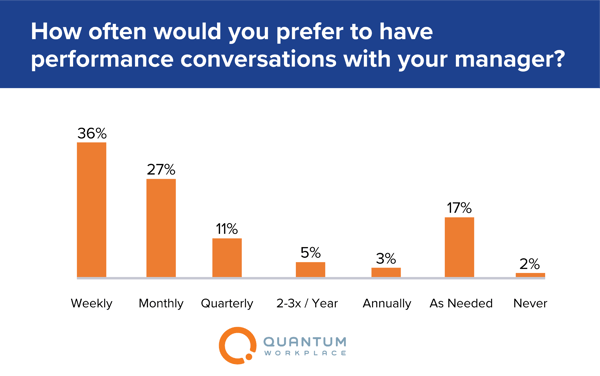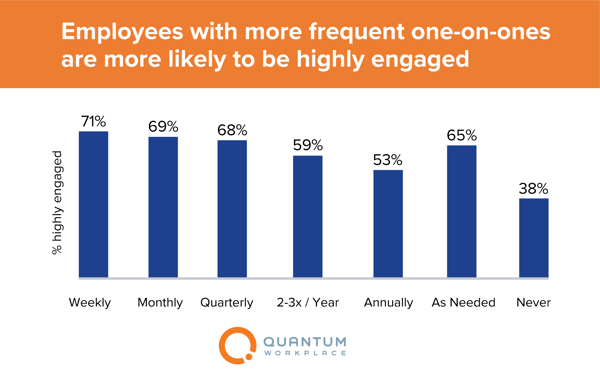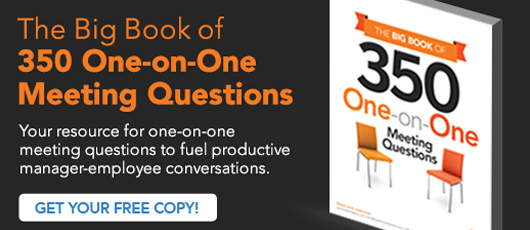The Best One-on-One Meeting Frequency According to Research
 One-on-one meetings between employees and managers are important. When conducted frequently, these meetings can serve as a valuable tool to bolster alignment, strengthen engagement, and drive employee growth.
One-on-one meetings between employees and managers are important. When conducted frequently, these meetings can serve as a valuable tool to bolster alignment, strengthen engagement, and drive employee growth.
One challenge managers often have with one-on-one meetings is figuring out the right meeting cadence. How often should you have one on one meetings? What’s the right balance for checking in with employees? What cadence is most engaging?
Read more to uncover our research and find an effective one-on-one frequency for each employee.
Why one-on-one meetings matter
One-on-ones are key to building strong relationships between managers and employees. Emails and instant messages are effective for the little things—like task updates and quick follow-ups—but one-on-one meetings are key to addressing roadblocks, boosting employee growth, increasing strategic alignment, and strengthening employee engagement.
One-on-ones equip employees with the tools they need to perform at their best. Without regular one-on-ones, employees may lack direction in their role. But with regular one-on-ones, you’ll reap many benefits—employees can better mitigate challenges, narrow their skills gaps, and understand available growth opportunities.
Plus, one-on-ones strengthen an employee’s connection to their work. When managers have a strong relationship with their employees, employees are better motivated to give their all—day in and day out. Your employees will genuinely care about the success of your business, and will be more aligned, engaged, and productive.
The optimal frequency for one-on-one meetings
Employees and managers meet at a variety of frequencies, making it tough to measure which cadence is the most effective. In fact, our research shows that:
- 38% of employees have weekly one-on-ones
- 19% of employees have monthly one-on-ones
- 8% of employees have quarterly one-on-ones
- 6% of employees have one-on-ones 2-3 times a year
- 7% of employees have one-on-ones annually
- 18% of employees have one-on-ones as needed.
This shows what employees and managers are doing now for one-on-one meetings. But what do employees prefer?

Our research shows that employees want weekly one-on-one meetings with their managers. Weekly one-on-ones strengthen the connection between managers and employees and enable them to discuss and respond to opportunities and obstacles in real-time. If managers can’t meet weekly with each employee, the next best option is monthly.
Our research also shows that different one-on-one meeting cadences impact levels of employee engagement. The engagement data matches with what employees want. The most engaged employees have weekly or monthly one-on-one meetings with their managers.

How to determine a one-on-one meeting cadence that works for you
While it’s important to prioritize one-on-ones at least monthly, everyone is different. Consider you and your employees’ individual needs to determine the best meeting cadence for you. Here are some tips to find a frequency that works:
1. Consider the number of direct reports you have.
The one-on-one frequency you adopt has to be realistic and attainable, or you’re likely to burn out and lack consistency. If you have a large team, it’s unrealistic to conduct a weekly, hour-long one-on-one with each employee—you’ll fill up your entire work week. Find a cadence that meets employees’ needs but still gives you the time you need to conduct business as usual.
2. Set one-on-one goals.
Determine the goals you want to accomplish with each one-on-one conversation. Perhaps you want to coach performance, build relationships, or discuss employee goals. Your priorities—and their connection to business success—can help you identify individuals who need an increased one-on-one frequency.
3. Try out different frequencies.
It’s important to stay open minded with your one-on-one cadence. At first, managers should try out different cadences. If you think your employees’ time could’ve been leveraged better outside of a meeting, consider reducing your frequency. If you think your employees would benefit from more one-on-ones, consider increasing your frequency. Be flexible and continually make adjustments as things change.
4. Request employee feedback.
It’s important to keep a pulse on your employees’ one-on-one meeting needs. During your meetings, ask employees if they think your current cadence is working, or if they prefer more or less one-on-ones. This feedback will help you ensure every meeting is effective and helpful for your employees.
5. Be consistent.
While it’s important to stay adaptable, consistency is key. Once you choose a frequency that works, avoid rescheduling or canceling meetings. Managers should determine a day and time of the week that works for each employee and stick to it. That way, employees can prepare for your conversations and aren’t left with issues that need to be addressed.
How to optimize your one-on-one meetings
Holding regular, effective one-on-one meetings can be tough without the right tools. Luckily, one-on-one meeting software can streamline your strategy to keep managers and employees connected and aligned. The right software will facilitate your conversations to increase employee and business success. With a robust platform, you can:
- Launch a 1-on-1 from anywhere, at any time
- Visualize cross-platform performance activity to provide adequate coaching
- Integrate goals and feedback features for better conversations
- Create templates to guide your conversations
- Automate 1-on-1 cycles to stay on track
An integrated one-on-one platform helps managers focus on what matters, facilitating the conversations that are key to your business. With the right tools, you can boost performance, increase trust, promote accountability, and drive success with ongoing one-on-ones.
Now that you have the background you need for ideal one-on-one meeting frequencies, understand what questions to ask. Download our Big Book of 350 One-on-one Meeting Questions to fuel your conversations.






